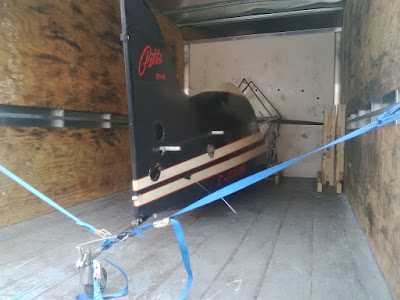Happy with my new idler, I tried a first fit in the torque tube and realized it was not aligned with its longitudinal axis. The idler had a non negligible nose left angle. I knew the idler was straight i.e. its angle was due to the torque tube tower bushings being misaligned. Here's a sketch to better visualize the problem. The black line is the perfect axis which is perpendicular to the longitudinal axis of the airplane. The blue line is to show how the actual axis of my torque tube was (exagerated):
In order to determine if the misalignment was excessive or not, I tried to connect the whole elevator linkages together with the torque tube + idler. It turned out I had very limited aileron movement due rod end bearings being at the end of their ±10° twisting range. This problem is well explained in a thread on Biplane Forum here.
After my efforts to build a new idler from scratch, finding out it didn't fit wasn't pleasant. However, I understood a little better what happened to the idler. My #1 theory for the twisted idler is now that the twist was done from day 0, in a bench vice. I suspect the builder originally had the same problem as above and decided to twist the idler instead of cutting the torque tube bushings and weld them again.
When I realized that, I decided to bite the bullet and fix the torque tube. In order to have the new bushings at 90° from the torque tube axis, I built a jig with blocks of wood aligned on a board. To align everything up, I used a piece of extruded aluminium of the same width as the OD of the torque tube, riveted with pop rivets:
Next step was to cut the old bushings and grind them down to the torque tube tower surfaces. After doing that I enlarged the LH bushing hole to the OD of the bushing. Here's what it looked like in the jig:
By doing that, it was clearly visible that the original bushings were not 90° from the torque tube axis:
After enlarging the RH side to allow the tube to reach the RH wood block, I finally had a welding jig ready. I removed some paint and gave it to my friend Mark so that he welds both sides in place. Here's the result:
Then I cut the tube to final bushing lengths:
I now have my torque tube tower axis at the right angle! Next step will be to prime and paint then reinstall in the airplane. Stay tuned!


















































